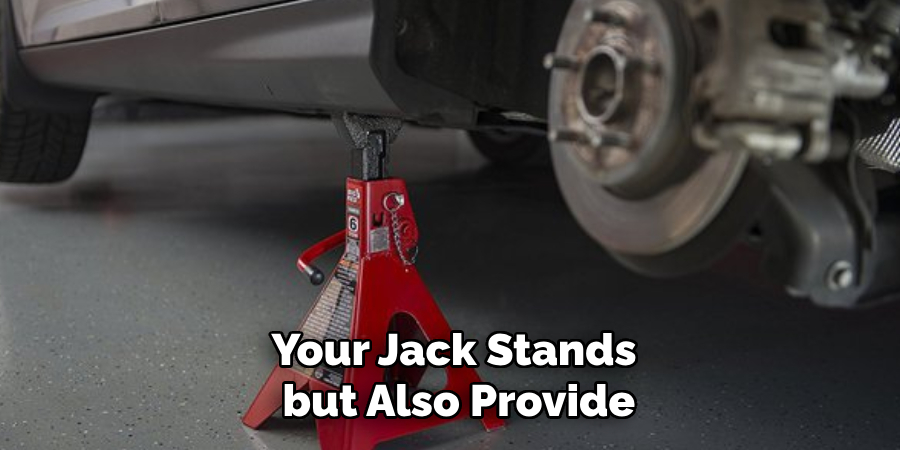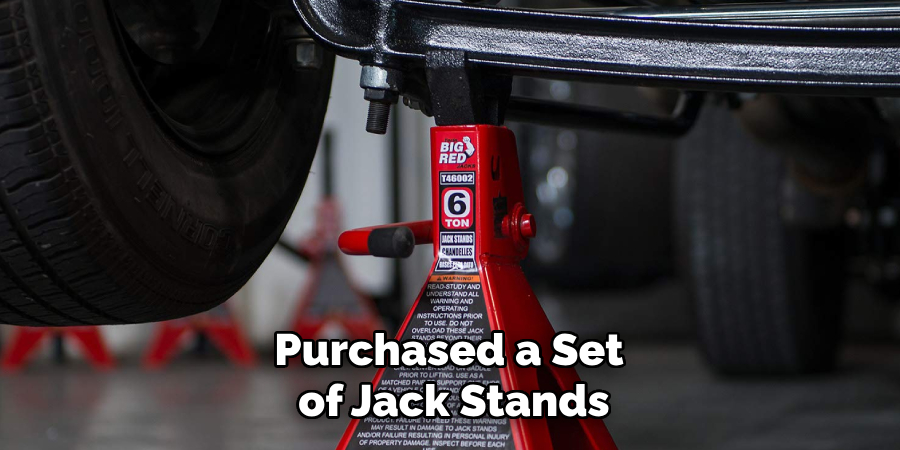Do you want to avoid tripping over your jack stands or having them clutter your garage? Storing jack stands can be a hassle if not done correctly. Here are some tips on how to store your jack stands safely and efficiently.

How to store jack stands is essential for maintaining their longevity and ensuring safety. Jack stands are critical for any automotive enthusiast or professional mechanic, providing stable support when working underneath a vehicle. However, when not in use, improper storage can lead to damage or rust, compromising their reliability.
This guide will explore the best practices for storing jack stands, focusing on tips to prevent wear and tear, minimize risk in your garage or workspace, and ensure they are ready for safe use whenever needed.
What Will You Need?
Before we dive into the different storage methods, here are some essential items you will need:
- Jack stands (obviously)
- A designated storage area
- Protective gear (e.g., gloves and safety glasses)
- Cleaning supplies (e.g., cleaner and lubricant)
Now that you have all the necessary materials let’s examine some practical ways to store your jack stands.
10 Easy Steps on How to Store Jack Stands
Step 1. Clean the Jack Stands:
Begin by thoroughly cleaning your jack stands to remove any dirt, grease, or debris that may have accumulated during use. Use a suitable cleaner to scrub away any grime, paying close attention to crevices where buildup can occur. Once cleaned, it’s crucial to dry the jack stands completely to prevent rust or corrosion. You can use a clean cloth or leave them in a dry, well-ventilated area. After ensuring they are dry, apply a light coat of lubricant to any moving parts to maintain smooth functionality.
Regular cleaning not only keeps your jack stands in optimal condition but also helps identify any potential damage or wear that needs attention.
Step 2. Choose a Suitable Storage Location:
Selecting the right storage spot for your jack stands is critical for preserving their condition and ensuring easy access when needed. Opt for a dry, cool area, preferably with limited exposure to humidity, to prevent rust development over time. Shelving units or designated tool storage areas in your garage are excellent options. Ensure that the location is sturdy enough to hold the weight of your jack stands and is away from areas prone to dust or dirt accumulation. Organizing a dedicated space can help prevent accidents and save time when you’re ready to use your tools again.

Step 3. Utilize Storage Racks or Hooks:
Storage racks or hooks can vastly improve the organization of your jack stands and free up floor space in your garage. Wall-mounted racks or heavy-duty hooks are ideal for keeping the stands off the ground and securely in place. Ensure the racks or hooks are sturdy and anchored into the wall studs for maximum stability. This method declutters your workspace and minimizes the risk of accidentally knocking over or tripping over your jack stands. By organizing them vertically, you maintain easy access and visibility, ensuring you can quickly grab them and go when needed.
Step 4. Group Jack Stands by Size or Type:
To further enhance the organization of your storage, consider grouping your jack stands by size or type. This categorization makes it easier to locate the specific jack stand you need and ensures that each type has its designated place. Whether you have a variety of sizes for different vehicles or specialized jack stands for particular tasks, keeping them sorted will streamline your workflow. Use labels or color-coded tags for quick identification, especially if you have an extensive collection.
This practice contributes to a tidier garage and minimizes the risk of using the wrong equipment, enhancing safety in your work environment.
Step 5. Use Protective Covers:
Protective covers or cases for your jack stands can significantly extend their lifespan by shielding them from dust, moisture, and potential scratches. Choose covers made from durable, water-resistant materials to ensure complete protection. If custom covers aren’t available, use heavy-duty plastic bags or wraps as a temporary solution. Covering each jack stand after cleaning reduces the chances of rust and corrosion, keeping them in pristine condition for the next use. This extra layer of protection enhances the longevity of your tools and maintains a clean and tidy appearance in your storage area.
Step 6. Regularly Inspect for Damage:
Regular inspections of your jack stands are crucial for ensuring their ongoing safety and functionality. Set aside time to check each jack stand for signs of wear and tear, such as cracks, bends, or rust spots. Pay special attention to the welds and locking mechanisms, as these areas are critical for maintaining the integrity of the stands while in use. If any damage is detected, assess the extent of the issue and determine whether professional repair is possible or if replacement is necessary. Regular checks not only prolong the life of your jack stands but also provide peace of mind, knowing that your equipment is in safe working condition whenever needed.

Step 7. Elevate and Secure Them Properly:
When organizing your jack stands within a storage area, elevating and securing them appropriately is essential to prevent accidental falls or damage. Use sturdy shelves or pallets to lift the stands off the ground, reducing their exposure to potential moisture from the floor. Securing them with straps or similar fasteners can prevent unwanted movement or tipping, ensuring they remain in designated spaces. This approach safeguards the jack stands from harm and maintains a neat, orderly storage area, helping you quickly locate and access the right equipment when needed.
Step 8. Maintain an Inventory List:
Keeping an inventory list of your jack stands and other tools can streamline your storage management system. Document their sizes, types, and any specific features that distinguish them from one another. This is especially useful if you have an extensive collection or share your workspace with others. An up-to-date inventory ensures that you know what you have, helping you avoid unnecessary purchases or misplacements. You can maintain the list digitally for easy updates and accessibility. This organizational strategy not only aids in equipment management but also supports effective planning for future projects or tool upgrades.
Step 9. Implement a Rotation System:
Incorporating a rotation system into your jack stand maintenance routine can ensure even wear and extend usability. Label each jack stand with a number or letter and document the last time each was used. Select the next set in sequential order when planning projects requiring jack stands. This method distributes use across all your equipment, preventing specific stands from being overutilized while others collect dust. By rotating your jack stands, you balance the workload, decreasing the likelihood of premature damage and helping maintain a dependable toolset that performs reliably each time you need it.

Step 10. Develop a Cleaning Schedule:
Establishing a regular cleaning schedule for your jack stands is essential for their upkeep and performance. Set specific intervals, such as monthly or quarterly, to clean each stand thoroughly. Remove any dirt, grease, or debris using appropriate cleaning solutions and tools. After cleaning, ensure they are scorched before returning to storage to prevent rust formation. Routine maintenance keeps your tools in optimal condition and ready for use, and it can help identify issues that need addressing during inspections. A clean, well-maintained set of jack stands contributes to a safe and efficient work environment, enhancing the longevity and reliability of your equipment.
By following these steps, you can establish an organized and efficient storage system for your jack stands.
5 Things You Should Avoid
- Leaving Them Outdoors: Exposure to the elements can rust and degrade the jack stands’ metal parts, compromising their safety and longevity.
- Storing on Soft Surfaces: Always store jack stands on a hard, stable surface to prevent them from tipping over or sinking, which can cause damage or create unsafe conditions.
- Stacking Them: Avoid stacking jack stands on each other, as this can lead to scratches, bending, or other structural damages that could ruin their effectiveness.
- Ignoring Maintenance: Failing to clean and inspect your jack stands for wear or damage before storage can lead to issues later. Proper maintenance helps identify problems that need to be addressed.
- Keeping Them Near Heat Sources: Intense heat can weaken the metal, reducing the jack stands’ load capacity. Ensure they are stored away from heaters, furnaces, or any other source of excessive heat.
Once you have purchased a set of jack stands, you must know how to properly take care of them to ensure their longevity and safety.

Conclusion
In conclusion, properly storing jack stands is crucial to maintain functionality and safety.
Always store them indoors in a dry environment to protect them from the elements and on a stable, level surface. Regular cleaning and inspection are necessary to identify potential issues early and prevent damage. Avoid risky practices such as stacking or placing them near heat sources. By following these guidelines, you can prolong the life of your jack stands and ensure they remain in optimal condition for future use.
Hopefully, the article on how to store jack stands has provided you with valuable information and tips for proper storage. Happy storing!
Edmund Sumlin is a skilled author for Metal Fixes, bringing 6 years of expertise in crafting a wide range of metal fixtures. With a strong background in metalwork, Edmund’s knowledge spans various types of fixtures, from decorative pieces to functional hardware, blending precision with creativity. His passion for metalworking and design has made him a trusted resource in the industry.
Professional Focus:
- Expert in Metal Fixtures : Edmund aesthetic specializes in creating durable and innovative metal fixtures, offering both appeal and functionality. His work reflects a deep understanding of metalworking techniques and materials.
- Sustainability Advocate : He is dedicated to using sustainable practices, ensuring that every fixture is crafted with eco-friendly methods while maintaining high-quality standards.
In his writing for Metal Fixes, Edmund provides valuable insights into the latest trends, techniques, and practical advice for those passionate about metal fixtures, whether they are professionals or DIY enthusiasts. His focus on combining artistry with engineering helps others discover the true potential of metal in design.


